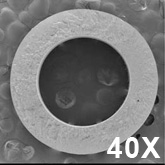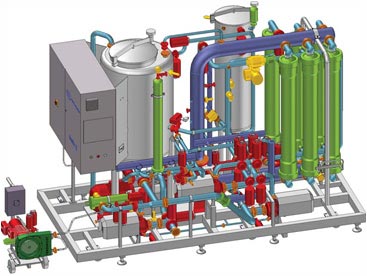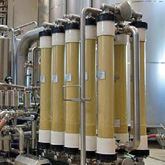Single Step Protein
Stabilization and Clarification
Protein stabilization and clarification are two critical steps to satisfying consumer expectations for a bright wine. While both steps prevent haze formation, one to remove heat sensitive proteins, the other suspended solids, the traditional commercial processes are typically carried out in consecutive phases adding labor, time and waste to the winemaking process. With Pall's new Oenofine XL Filtration System, wineries can now combine these operations into a single cost saving process step.
Providing Sustainable Value
By increasing yields, reducing waste volumes and combining process steps, the Oenofine XL systems provide wineries with a cost saving sustainable alternative to traditional wine stabilization and clarification methods.Benefits
Cost Savings
- Combined stabilization and clarification steps
- Reduced waste and wine lees volumes
- Reduced labor and handling
Sustainability
- Reduction in solid waste for landfill
- Up to 30% less bentonite consumption
- No filter aid (DE) requirement
- Up to 50% reduction in energy and water consumption
- Higher yields, lower product loss
- Eliminates exposure or inhalation of potential carcinogen (DE)
Brand Protection
- Consistent filtrate quality with Pall's proven PVDF membranes
- Data monitoring and process trend recording
- Food contact compliance
Creating Value
- Eliminates settling time after traditional protein stabilization
- Increases winery turn-over or tank space capacity
- Flexibility to use for clarification only
Food Contact Compliance
- Pall Oenofine XL Filtration Systems Declaration of Compliance
Unique Bentonite
Pall recommends the use of of Erbsloh's Ultrabent Poretec UF or Blancobent UF bentonite for protein stabilization of wine in conjunction with the Oenofine XL system. These products have a well-defined particle size distribution enabling wear-resistant and gentle application with membrane systems. For further information on Ultrabent Poretec UF and Blancobent UP, please contact your local Erbsloh representative.Proven Membrane
 At the heart of the Oenofine XL system, is a Pall hollow fiber membrane that has been proven in wine clarification applications for over 10 years. Developed specifically for wine use, the membranes have negligible impact on wine characteristics and the capacity to handle high solids. Constructed from robust polyvinylidene fluoride (PVDF), the symmetric membrane permits high flow performance and long filtration runs without irreversible plugging. The Oenofine XL membranes' high mechanical strength ensures wear-resistance when exposed to typical wine contaminants like fining agents, crystals or solids left over from upstream processing which other hollow fibers cannot tolerate. When coupled with the capability to backflush, the Oenofine XL modules demonstrate high solids operation and long service life making them ideal for the combined stabilization and clarification task. Additionally at 21.5 m2 of filter area, the PVDF modules have more than twice the filter area of competitive hollow fiber clarification modules. The high flow modules enable compact and economical systems.
At the heart of the Oenofine XL system, is a Pall hollow fiber membrane that has been proven in wine clarification applications for over 10 years. Developed specifically for wine use, the membranes have negligible impact on wine characteristics and the capacity to handle high solids. Constructed from robust polyvinylidene fluoride (PVDF), the symmetric membrane permits high flow performance and long filtration runs without irreversible plugging. The Oenofine XL membranes' high mechanical strength ensures wear-resistance when exposed to typical wine contaminants like fining agents, crystals or solids left over from upstream processing which other hollow fibers cannot tolerate. When coupled with the capability to backflush, the Oenofine XL modules demonstrate high solids operation and long service life making them ideal for the combined stabilization and clarification task. Additionally at 21.5 m2 of filter area, the PVDF modules have more than twice the filter area of competitive hollow fiber clarification modules. The high flow modules enable compact and economical systems.Traditional Protein Stabilization
Bentonite fining is the current industry standard for protein stabilization of white wine. While the traditional method is effective, the settling time, labor and handling, and waste associated with the existing process can add significant costs and limit a winery's overall capacity. Bentonite, being negatively charged, can bind positively charged proteins in wine to prevent precipitation in the bottle. Although bentonite reaction time occurs almost instantaneously, wineries will typically allow days of settling prior to downstream processing. Long settling time generally improves filterability and is even a requirement for some membrane filtration systems, however, on the other hand, it can also be viewed as unfavorable due to protein discharging from bentonite platelets. Additionally depending on the type of bentonite, the lees volume after treatment can range from 2 to 10 % leading to high waste disposal volumes or the necessity to implement further labor intensive and quality reducing steps to recover more wine.Wine Clarification
After protein stabilization, filtration is typically carried out to remove suspended solids and further prepare the wine for additional steps prior to bottling. Various methods of filtration may be employed. Diatomaceous Earth (DE) and sheet filters are the more classical filtration technologies and may be combined or used in multiple stages to achieve the filtrate quality requirement. In recent years, crossflow filtration systems have become a widespread cost saving alternative to the traditional filtration techniques. Crossflow filtration eliminates the use and disposal of filter aids, has low water and energy consumption and provides consistent wine quality with minimal preparation and labor. With many modern crossflow systems bentonite can cause irreversible fouling or abrasive action on the membrane surface which can ultimately jeopardize membrane integrity. Pall's newest development, the Oenofine XL system overcomes these obstacles. Proprietary activated bentonite from Erbsloh, Ultrabent Poretec UF or BlancoBent UF is dosed upstream of the hollow fiber membranes resulting in single step protein stabilization and clarification. The Pall Oenofine XL system enables wineries to reduce bentonite consumption, eliminate settling time after bentonite fining, and reduce wine waste and lees volumes. Additionally by reducing the turn around time for fining and filtration, wineries can even increase their total production capacity.Quality and Maintenance
The Oenofine XL system utilizes components with proven reliability from well-known, industry-accepted manufacturers. This allows for convenient supply of spare parts anywhere in the world.Typical Average Performance Over 4 to 6 Hours of Operation
| Oenofine System | Flow Rate | |
| Wine Stabilization | Wine Clarification | |
| XL-6A | 65 hl/hr | 50 - 105 hl/hr |
| XL-8A | 86 hl/hr | 65 - 140 hl/hr |
| XL-10A | 108 hl/hr | 85 - 172 hl/hr |
| XL-12A | 130 hl/hr | 105 - 205 hl/hr |
| XL-14A | 150 hl/hr | 120 - 240 hl/hr |
| XL-16A | 172 hl/hr | 135 - 275 hl/hr |
| XL-18A | 195 hl/hr | 155 - 310 hl/hr |
Systems
Flexible System Design
The Oenofine XL system is a fully automated crossflow hollow fiber system available from 6 to 18 modules. A small dosing skid allows automatic control of the bentonite addition for stabilization. As an option, Pall can provide a dosing tank and supplementary skid for solids evacuation and system storage in the case of a power failure. Additionally, the flexible software enables wine clarification without stabilization, similar to Pall's Oenoflow XL systems. Pall offers a wide range of customizable options including but not limited to:- A dosing tank
- A supplemental support system (for power loss)
- Low Concentrate Volume (LCV) (for Clarification only)
- Dual Pre-filter screens
- Nitrogen purge and blanketing
- Tank Distribution System
- An on-line turbidity meter

Our wine system specialists are available to assist in selection of the appropriate system and options. Please contact us.
Earn 10% off* your next order online by leaving a review of this product. Please login to your account to leave a review. We appreciate and value your feedback.
*Subject to Terms and Conditions.



